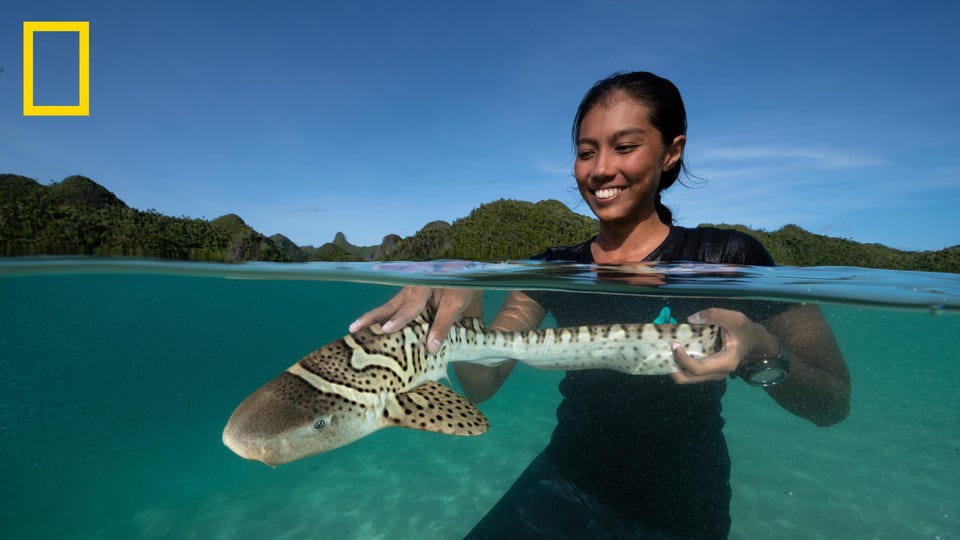Forbes Innovation Science World’s First Major Science-Backed Shark Reintroduction A Success Melissa Cristina Márquez Contributor Opinions expressed by Forbes Contributors are their own. I write about the latest, exciting research on sharks worldwide! Following Mar 16, 2023, 07:27pm EDT | Press play to listen to this article! Got it! Share to Facebook Share to Twitter Share to Linkedin “There she goes!” one of the team members cried out in joy. Scientist Nesha Ichida couldn’t tell who the cheer came from, her eyes focused intently on the small spotted shark in her hands that was bobbing on the surface of the warm, turquoise ocean water.
A member of the family Stegostomatidae, the zebra shark ( Stegostoma tigrinum ) she currently held onto was named Kathlyn – and Kathlyn was a little shark making big history. Nesha Ichida gently ferries a juvenile zebra shark through the sea pen on Kri Island to a team of . .
. [+] shark caretakers for the shark’s final health check the day before it’s released to the wild. David Doubilet and Jennifer Hayes, National Geographic Kathlyn wriggled out of Nesha’s hands into the waters of Indonesia’s Wayag Islands, the first time she would swim out in the open ocean.
Kathlyn and Charlie (a male zebra shark that had been released earlier that day) were a beacon of hope for scientists from aquariums around the world that were working together to rebuild the wild population of zebra sharks that have been wiped out from overfishing and shark finning. A large shark that undergoes a radical transformation in coloration with age, this animal lives in shallow coral reef habitats in warm tropical waters. As the zebra shark ages, it sheds its black-and-white stripes for small black dots on a tan body, closely resembling the leopard.
Their ability to wriggle into narrow crevices and caves allows them to find food here, such as small fish, snails, sea urchins, crabs and other small invertebrates. Many inshore fisheries take the zebra shark for its meat, which may be sold fresh or salt-dried in Indonesia, Thailand, Malaysia, Philippines, and other countries. As well as its liver for vitamins, shark fin soup is made from its fins.
The day before the very first two juveni le sharks, Charlie and Kathlyn, are released into the wild, . . .
[+] handlers at a sea pen on Kri Island stretch one of them to measure it and check its health for the very last time. David Doubilet and Jennifer Hayes, National Geographic ReShark is an international project that releases aquarium-bred zebra sharks into marine protected areas such as Raja Ampat with the help of shark nannies and scientists. Made up of 75 partners from 15 countries, 44 aquariums have bred these gentle predators from eggs to pups to juveniles.
Like Kathlyn and Charlie, future zebra shark pups will be released into Marine Protected Areas patrolled by conservation rangers. The project marks the first-ever efforts to restore sharks in areas where they are extinct. .
. and it took years to get here! “While scientists rewild animals on land all the time, no one has ever tried to do the same with endangered sharks – until now. [.
. . ] The first two baby sharks, Charlie and Kat, have been successfully released, while the team hopes to release 500 more over the next several years,” the National Geographic press release stated .
Scientists hope that this same framework can be used for other endangered shark species, slowly ‘rewilding’ their struggling populations and giving them a much-needed numbers boost. MORE FOR YOU Why The Rock’s Social Media Muscle Made Him Hollywood’s Highest-Paid Actor Ferrari Unveils Roma Spider: First Look Shadowdark Looks Back At Dungeon Crawls With An Eye To The Future Scientist Nesha Ichida releases the second zebra shark of the day, a young female named Kathlyn, in . .
. [+] Indonesia’s Wayag Islands. Ichida is part of a new group, ReShark, led by 44 aquariums from around the world, that aims to rebuild endangered shark populations by reintroducing sharks raised in captivity to their native waters.
(Ichida had released Charlie, Kathlyn’s older sibling, and the very first shark set free through this program, 20 minutes earlier. ) David Doubile t and Jennifer Hayes, National Geographic “The ReShark collective is committed to ensuring that wherever in the world we are working, that work happens shoulder-to-shoulder with local communities, government agencies and elected officials and leading conservationists,” the project’s website says. “Our goal is to ensure that our efforts are sustainable, culturally respectful and add value to both the local environment as well as the communities who live alongside them.
” Follow me on Twitter or LinkedIn . Check out my website . Melissa Cristina Márquez Editorial Standards Print Reprints & Permissions.
From: forbes
URL: https://www.forbes.com/sites/melissacristinamarquez/2023/03/16/worlds-first-major-science-backed-shark-reintroduction-a-success/



